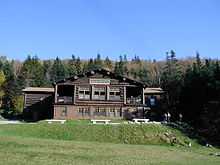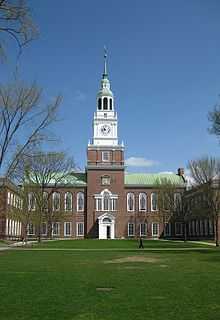Dartmouth Outing Club
The Dartmouth Outing Club (DOC) is the oldest and largest collegiate outing club in the United States.[1] Proposed in 1909 by Dartmouth College student Fred Harris to "stimulate interest in out-of-door winter sports", the club soon grew to encompass the College's year-round outdoor recreation and has had a major role in defining Dartmouth College.

Today the club has over 1500 student members (and almost as many non-student members) and acts as an umbrella organization for about a dozen member clubs which each specialize in an aspect of outdoor recreation. The DOC and its member clubs are student-run clubs for students, but many alums, faculty, staff, and community members participate in and contribute to the clubs. Anyone can become a member and non-members can participate in most activities.
Member clubs
- Dartmouth Ski Team
- Competitive Varsity, Division 1 Nordic and Alpine ski teams.
- Bait and Bullet
- Organizes fishing and hunting trips.
- The Big Green Bus
- Promotes sustainable living, environmental awareness, and alternative energy use through education and example. The Big Green Bus embarks on a 10-week cross country summer tour annually.
- Cabin and Trail
- Organizes hiking and trailwork trips. Responsible for the construction and maintenance of cabins, shelters, and 75 miles (121 km) of the Appalachian National Scenic Trail, as well as a network of trails on Mt. Moosilauke. The Forestry Team competes against other schools in New England and Canada in all types of forestry events from sawing to axe throwing.
- Environmental Studies Division
- Organizes environmental education and activism.
- Ledyard Canoe Club
- Organizes canoeing and kayaking trips and competitions.
- Dartmouth Mountaineering Club
- Organizes rock and ice climbing trips and competitions. Founded in 1936 by Jack Durrance, the Dartmouth Mountaineering Club is a student-run club dedicated to exploring climbing around the world and introducing beginners to the sport. The nearby climbing areas most frequented by members of the club are Winslow Cliffs near the Dartmouth Skiway; Rumney, an East Coast sport climbing venue that attracts climbers from as far away as Montreal and Boston; Cannon Cliff in Franconia Notch; and Cathedral and Whitehorse Ledges near North Conway. Every term, the club runs four beginner trips out to either Rumney or Winslow, one intermediate/advanced trip to Cathedral or Cannon, and one weekend trip to the Shawangunks in New Paltz, New York. In the winter, DMC clubbers ice climb at Holt's Ledge, Rumney, and Crawford Notch near Mt. Washington. When spring break rolls around, the DMC ventures out West to climb in a warmer locale for two weeks. For the past two years, Red Rocks, Nevada has been the destination of choice.
- DMC members seeking adventure can apply for money from the Mountaineering Club Expeditionary Fund. Initially established in 1963 as the John E. Breitenbach Memorial Fund and later renamed in 1973, its stated purpose is to fund expeditions planned and executed by club members. After their travels, once they are back on campus, the students present a slide-show of their experiences to the Dartmouth community, so sharing what they learned and accomplished.
- Dartmouth Ski Patrol
- Provides patrol and rescue on the Dartmouth Skiway and provides medical and safety support to the other member clubs.
- Dartmouth Organic Farm
- Organizes student participation at the Dartmouth Organic Farm and raises awareness about organic farming.
- Mountain Biking Club
- Organizes mountain biking trips to local areas such as Kingdom Trails in East Burke, VT and Highland Downhill Mountain Bike Park in Northfield, New Hampshire. There have also been trips over spring break to Asheville, North Carolina area.
- Winter Sports Club
- Organizes backcountry skiing and winter mountaineering trips. Trips are run to local mountains in New Hampshire and Vermont as well as an annual trip to Mount Katahdin in Maine. Smaller trips have been funded to Rogers Pass near Revelstoke, British Columbia and the Wasatch Range in Utah.
- Women in the Wilderness
- Develops out-of-door confidence and leadership skills and organizes outdoor trips for women spanning many of the Outing Club's activities.
Affiliated programs and facilities
- Second College Grant
- 26,800 acres (108 km²) owned by the College in northern New Hampshire.
- Mount Moosilauke
- The southwesternmost 4,000-foot (1,200 m) mountain of the White Mountains of New Hampshire and the home of the Moosilauke Ravine Lodge.
- Dartmouth Outdoor Rentals
- Outdoor gear rental and workshops.
- Dartmouth Cross Country Ski Center
- Ski and skate rentals.
- Daniels Climbing Gym
- Bouldering cave and training facility.
- Dartmouth Organic Farm
- Organic teaching farm.
- Robinson Hall
- The DOC headquarters was built for the Club and certain other "non-athletic student organizations" in 1915. The DOC continues to share the building with a variety of groups.
History
Fred Harris, a member of the Dartmouth College class of 1911, proposed in 1909 an outing club which would stimulate outdoor interest during the cold, winter months through skiing and snowshoeing. The club's first "formal" meeting took place on December 14, 1909 in the South Fayerweather dormitory.[1] In 1910, a "Field Day" was established, which was a simple gathering time for groups to participate in outdoor activities. By 1911, the club had decided to enhance the Field Day by inviting women, holding further social festivities, and renaming it the "Winter Carnival", an event which has been carried out every year since, excepting 1918 (due to lack of coal and wood).
Outing Club membership increased steadily, until by 1920, two-thirds of the student body were members. In February of that year, Fred Harris wrote an article in National Geographic Magazine entitled "Skiing over the New Hampshire Hills" primarily about the Dartmouth Outing Club. The spring after this article was published, the number of applicants to the College increased from 825 to 2625, forcing the College to become selective in admission for the first time.[1]
In 1929, the Club built the Dartmouth Outing Club House on Occom Pond in Hanover. 1935 saw the introduction of Freshman Trips to encourage participation in the Club, a tradition which is now among the largest pre-orientation programs in the country. By 1956, the Dartmouth Skiway was built at Holt's Ledge, replacing Oak Hill as the primary downhill skiing facility for the College. That same year, President Eisenhower joined the DOC.[1]
Mount Moosilauke and the White Mountains

The club had acquired a log cabin at the base of Mount Moosilauke by 1913, and was building another cabin nearby. Upon hearing this news, Johnny Johnson, Dartmouth class of 1866, decided to donate much of his real estate investments to the Club. His donations led to a chain of cabins through the White Mountains, reaching a peak of 30 in number during the 1930s.
In 1926, the Club's trail officially became a 75-mile (121 km) part of the Appalachian National Scenic Trail, and member clubs such as Cabin and Trail began to be formed. The same year, the DOC established the Intercollegiate Winter Sports Union. The Club was soon granted the Moosilauke Summit House, which served as a hotel and received nearly 3300 guests per year.
1935 saw the fire which destroyed Moosilauke's log cabin. After further investment in surrounding lands, the Moosilauke Ravine Lodge was built in 1939 as one of the largest log buildings in New Hampshire. Today, the Lodge serves as the culminating location of the Freshman Trips and a base for many of the DOC's other activities.
See also
References
External links
- DOC Wiki
- Dartmouth Outing Club
- Dartmouth Outing Club of Northern California
- Moosilauke Ravine Lodge
- Links to each of the member clubs
- History of the DOC
- History of DOC skiing
| |||||||||||||||||||||||||
